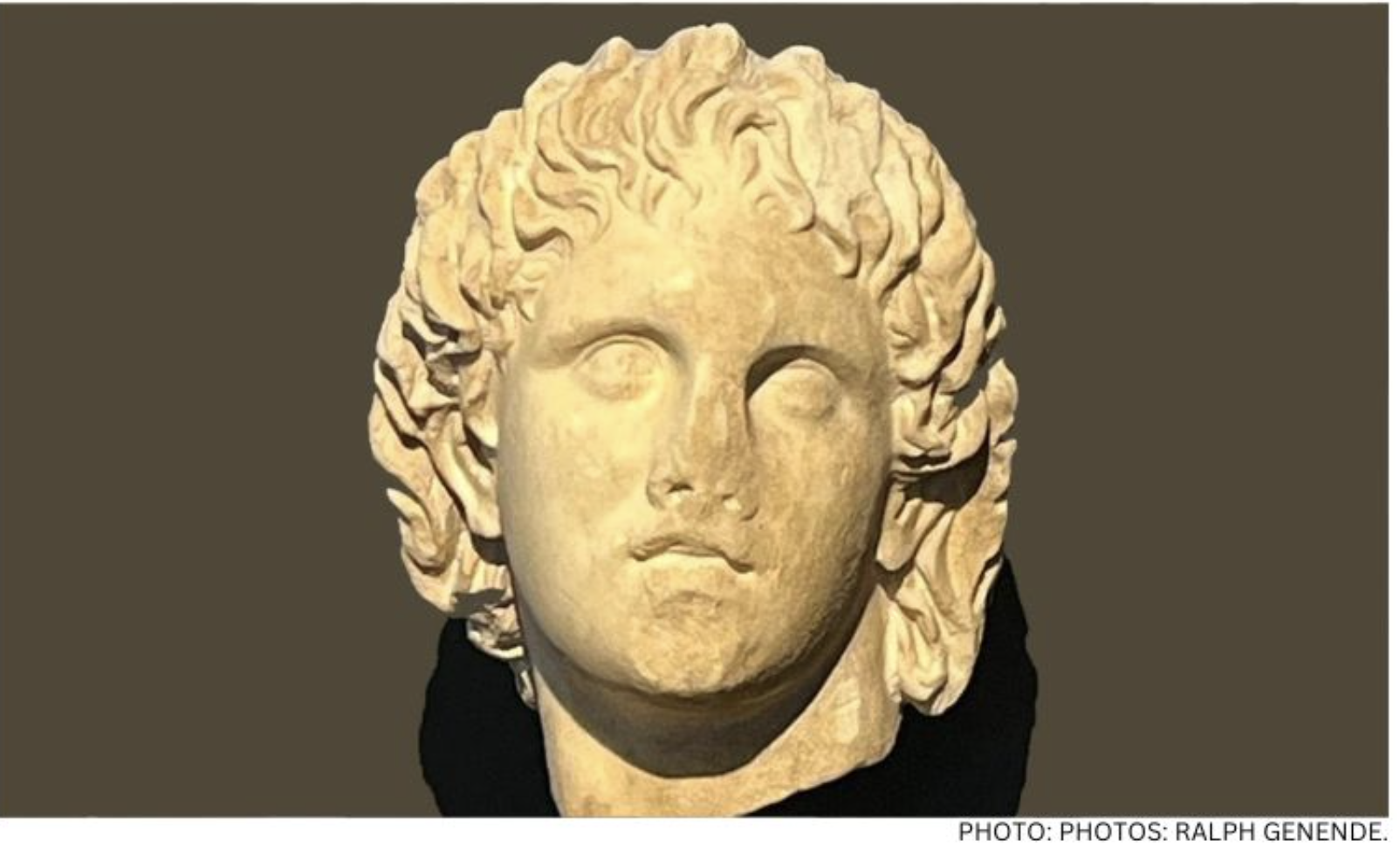RALPH GENENDE joins PAUL FORGASZ on a Jewish tour of Greece.
There’s a small tree and a little poem on a plinth, easy to overlook, but a pity to miss, as you walk alongside the ancient city walls of the old town of Rhodes in Greece.
Written in Greek, it reads:
You the passer by, you who love me
let the others admire the castles and listen to me:
My fate has been marked by a ravine singer
and the trembling in my foliage, it’s a song
the deep voice of life.
For you a sweet memory
but l, a tiny tree,
I need it for faith, to grow taller and taller
and stare beyond these walls.
(Fotos Varelis)

In many ways this poem sums up a remarkable Grecian trip that Melbourne educator Paul Forgasz recently led for a group of Australian Jews.
We admired antique castles and tombs, statues and objects of delicacy and beauty. There were the majestic statues of the museums of Athens and beyond, the peerless horseman at the Delphi Museum, every vein pulsing with movement; he is still in motion. We travelled into the mountain ranges to see the Meteora monasteries perched on unimaginable eagles’ lairs; temples in the air stimulating the soul to soar. Meteors of the mountains.
Who could fail to remember the glorious golden crowns of the father of Alexander the Great and Philip II, not to mention their astonishingly well-preserved stately burial tomb in Vergina (the unplundered tomb was discovered in 1977). And who wouldn’t remember the Greek arena on Rhodes with its stately stadium (special stone seats for the notables). I won’t forget the oratorium, a boutique mini-auditorium alongside the main arena, built for the eloquent speakers of the day. I’m looking for an architect to design one for my home.

Like countless others we will hold the memory of the eternal Acropolis, not just as a breakfast backdrop at our hotel but as an immense presence brooding over Athens. We will long sigh at the memory of the tiny and so finely detailed and intricate ancient figurines carved on a piece of ivory two-by-two in the breathtaking museum in Vergina.
In Greece you cannot fail to be humbled by the sweep of history, epitomised by the numerous busts of a young Alexander the Great striding across the mountains and the centuries. A leader surely fired by the memory of his powerful father and his formidable teacher, Aristotle. They knew a thing or two, these ancients. Things we had to rediscover and uncover in the layers of sand and century.
Now I understand better how the brilliant polyglot and conqueror bedazzled our rabbis and sages of antiquity, so they claimed him as a saviour of sorts.
Alexander became a popular name for Jewish boys, and Josephus the historian was rapturous about an ostensible meeting between Alexander and the Kohen Gadol, or high priest, when he visited Jerusalem. He presented the king with the Jewish community’s capitulation; then Alexander offered a sacrifice in the Jerusalem Temple. In this story, not only did Alexander make a detour in order to meet with the Jews and go to Jerusalem, but when he saw the high priest and the name of God, he was so awed that he bowed down. Alexander, according to this legend, recognised the greatness of the God of Israel. But it seems to me it’s more about our sages acknowledging the stature of Alexander.
But for all this reverent history, we were also here to learn of Jewish life in Greece and a fate often marked by “ravines and trembling in the foliage.” These were the deep ravines of Jewish persecution and suffering across time, but more recently the fear and trembling of the Romaniote and Sephardi Jewish population seeking refuge in the sparse foliage from their Nazi persecutors.
Everywhere is the haunting absence of one of the oldest Jewish communities, the Romaniote, that can trace its origins back over 2000 years. Now just a few Romaniote and Sephardi remnants (most descendants of those escaping the Inquisition and expulsion from Spain) in beautifully desolate or desultory shuls in Volos and Ioannina. On Shabbat in Athens, the Torah reader among the few people who gathered was the lone remaining Romaniote. The proud Sephardic community is fading away; you catch a glimpse of its power and history in the old Ladino language prayers incorporated into the local Siddur.
Greece is becoming Judenrein despite the Herculean efforts of some amazing individuals and inspiring leaders. The tortured stone figures of the Shoah monuments in Thessaloniki, Larrisa and Volos, the six simple slabs in Athens, cry out in their aching simplicity and the empathetic spirit of their non-Jewish creators.
What especially tore at me and my fellow travellers was the beautiful little restored wooden shul of Veria, on the shores of the Tripotamos River. This exquisitely simple and colourful structure located in the intact Barbouta, the Jewish quarter built in the mid-19th century, was an easy place to round up the remaining 460 Jews, including many children.

The tiny desks housed in the shul today are a sorrowful reminder of their murder. The poignant letters of current Verian schoolchildren written to these children are like the astonishing 2019 “The Thread of Memory” project of the town, a moving tribute by some of the Greeks who are now recognising the proud and singular contribution of their former Jewish neighbours and citizens. The project featured a march that included the unfurling of a 3km red thread by students and participants, beginning in front of the synagogue in the former Jewish quarter and ending at the railway station where the Jews were sent to Auschwitz. A thread of blood, a delicate Ariadne thread of Greek myth left dangling in the labyrinth of human destructiveness.
Being here was a humbling reminder that our “Ashkenazi Shoah”’ of Poland and Lithuania, Germany and Hungary, was only part of the inventory of horror. There was also the “Sephardi Shoah” of Greece and Italy, Portugal and Denmark.

Thessaloniki had its Black Sabbath and its deportations, and the destruction of almost the entire community. The numbers were of course nowhere near the losses of Eastern Europe, but the proportion was even higher with over 90 per cent of Greek Jewry decimated.
Being here with the magic of Forgasz was a privilege for the rich evocation of the culture and the traditions of this country, for the challenges and existential issues that Paul so skilfully wove.
Who needed to know about the travels and epistles of the New Testamental Paul in Greece seeking to win over Jews and pagans, when you travelled with the Old Testamental Paul speaking his truth and pricking holes into our inflated understanding of who the Maccabees actually were.
Reading the apocryphal Books of Maccabees alongside the Talmudic accounts of Chanukah challenges your traditional understanding of the origins of this festival and its meaning. It gets you thinking about today; when the contemporary zealots (latter-day Maccabees?) and the Hellenists or acculturated Israelis confront each other on the streets of Tel Aviv and Jerusalem. Being here, we wondered how the Jews of Greece read the Chanukah story in their siddurim: “The Greeks gathered to oppress us”. The young Greek rabbi of Athens provided the answer. They substitute the word Seleucid for Greek; a clever sleight of hand given it was the Seleucid and not Ptolemaic Greeks who were the oppressors of the Jews!
Despite the depressing presence of absence, we were simply astounded by the determination and resilience of Jewish community leaders we met across the country. We were deeply moved by our non-Jewish Greek guide, her respect for the Jewish roots of this community and passion for promoting the current generation. She sends her own children to the Jewish primary school of Thessaloniki.
The simple song of the little tree and its desperate hope to connect to the deep voice of life is diminishing and apparently disappearing. I would like to believe that this ancient community won’t become just another sweet memory of our bitter past. That somehow it will find another way, to restore the faith, to grow taller and taller and stare beyond these hard walls of time.
Photos: Ralph Genende




Be joyful!